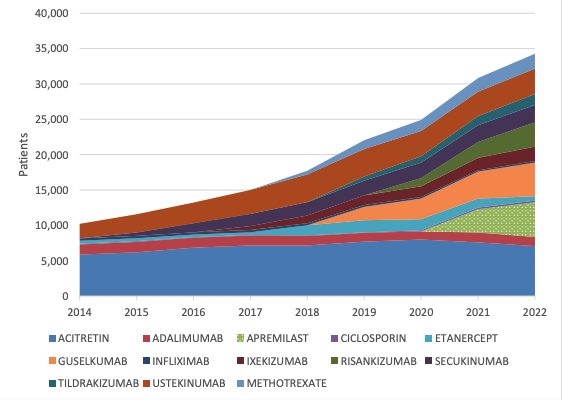Use of apremilast for chronic plaque psoriasis has increased steadily since it was PBS listed in 2021 but overall usage has been less than expected as biologic therapies become widely used, a new analysis shows.
A two-year post-listing review (link here) by the PBS drug utilisation sub-committee (DUSC) found that the small-molecule inhibitor of phosphodiesterase 4 (PDE4) was prescribed for 3,312 patients in 2021, with numbers rising ten-fold to 31,121 patients in 2023.
However the number of prescriptions was less than estimated, perhaps because elderly and younger patients with chronic plaque psoriasis (CPP) may have received only one dose per day, the report from the September 2023 meeting found.
While the use of non-biologic therapies such as acitretin remained relatively stable over the last few years, the use of biologics for plaque psoriasis increased with the PBS listing of IL -17 inhibitors (izekizumab, secukinumab) and IL-23 inhibitors (guselkuzumab, risankisumab, tildrakizumab), the DUSC review found.

Number of patients treated for chronic plaque psoriasis, by therapy and year (DUSC)
The number of CPP patients treated with biologic therapies increased from about 4,000 in 2014 to almost 20,000 in 2022, PBS figures showed.
Prescription sequence analysis showed that there was an increase in patients switching from apremilast to a biologic, particularly the recently listed IL-23 inhibitors.
Following the listing of apremilast for CPP, 8% were initiated on the drug, compared to 38% on biologics and 38% on non-biologic therapies. About 8% of patients switched from non-biologic to biologic therapies and 3% from apremilast to biologic therapies.
The DUSC remarked that some patients “may have preferred treatment with apremilast due to its oral administration and [it was] considered to be relatively safe.”
The proportion of patients who initiated treatment with a dermatologist fell slightly after 2022 when new PBS criteria allowed accredited dermatology registrars to initiate treatment in consultation with a dermatologist and GPs to prescribe maintenance treatment in consultation with a dermatologist or accredited dermatology registrar.